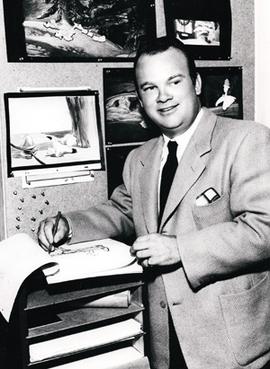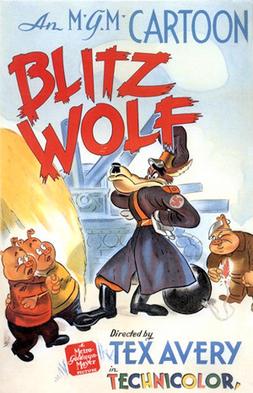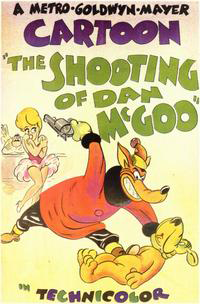
Frederick Bean "Tex" Avery was an American animator, cartoonist, director, and voice actor. He was known for directing and producing animated cartoons during the golden age of American animation. His most significant work was for the Warner Bros. and Metro-Goldwyn-Mayer studios, where he was crucial in the creation and evolution of famous animated characters such as Bugs Bunny, Daffy Duck, Porky Pig, Elmer Fudd, Droopy, Screwy Squirrel, The Wolf, Red Hot Riding Hood, and George and Junior.

Droopy is an animated character from the golden age of American animation. He is an anthropomorphic white Basset Hound with a droopy face; hence his name. He was created in 1943 by Tex Avery for theatrical cartoon shorts produced by the Metro-Goldwyn-Mayer cartoon studio. Essentially the polar opposite of Avery's other MGM character, the loud and wacky Screwy Squirrel, Droopy moves slowly and lethargically, speaks in a jowly monotone voice, and—though hardly an imposing character—is shrewd enough to outwit his enemies. When finally roused to anger, often by a bad guy laughing heartily at him, Droopy is capable of beating adversaries many times his size with a comical thrashing.

Red, also known as Miss Vavoom in the 1990s, is an American animated character, created by Tex Avery, who appears in several MGM short films and Tom and Jerry films. She is a fictional nightclub singer and dancer who is usually making all men in the room crazy, especially a Wolf character who — in vain — tries to seduce and chase her. Red debuted in MGM's Red Hot Riding Hood, a modern-day variant of the fairy tale "Little Red Riding Hood".
Screwy Squirrel is an animated cartoon character, an anthropomorphic squirrel created by Tex Avery for Metro-Goldwyn-Mayer. He is generally considered the wackiest and outright most antagonistic of the screwball cartoon characters of the 1940s.

Red Hot Riding Hood is an animated cartoon short subject, directed by Tex Avery and released with the movie Dr. Gillespie's Criminal Case on May 8, 1943, by Metro-Goldwyn-Mayer. In 1994, it was voted number 7 of The 50 Greatest Cartoons of all time by members of the animation field, making it the highest ranked MGM cartoon on the list. It is one of Avery's most popular cartoons, inspiring several of his own "sequel" shorts as well as influencing other cartoons and feature films for years afterward.

Mouse Trouble is a 1944 American one-reel animated cartoon short and is the 17th Tom and Jerry short produced by Fred Quimby. It was directed by William Hanna and Joseph Barbera, with music direction by Scott Bradley. The cartoon was animated by Ray Patterson, Irven Spence, Ken Muse and Pete Burness. Mouse Trouble won the 1944 Oscar for Best Animated Short Film, the second consecutive award bestowed upon the series. It was released in theatres on November 23, 1944 by Metro-Goldwyn Mayer and reissued on December 12, 1951.

Leo the Lion is the mascot for the Hollywood film studio Metro-Goldwyn-Mayer and one of its predecessors, Goldwyn Pictures, featured in the studio's production logo, which was created by the Paramount Pictures art director Lionel S. Reiss.

King-Size Canary is an animated cartoon short that debuted in movie theaters in 1947. It was produced by Metro-Goldwyn-Mayer and directed by Tex Avery. The canary in this short was a primary inspiration for the design of Maurice, a character from The Wacky World of Tex Avery.

Cat and Dupli-cat is a 1967 Tom and Jerry short produced by Chuck Jones and MGM Animation/Visual Arts for Metro-Goldwyn-Mayer. It was directed by Chuck Jones and Maurice Noble, written by Jones and Michael Maltese, and animated by Dick Thompson, Ben Washam, Ken Harris, Don Towsley and Tom Ray.

Cannery Rodent is a 1967 Tom and Jerry cartoon produced, written and directed by Chuck Jones. It was the final Tom and Jerry cartoon written and directed by Chuck Jones, and one of the last of the theatrical Tom and Jerry cartoons to be released by MGM.
Tee for Two is a 1945 American one-reel Technicolor animated cartoon and is the 20th Tom and Jerry short, first released to theaters on July 21, 1945 by Metro-Goldwyn-Mayer. The short is directed by William Hanna and Joseph Barbera, composed by Scott Bradley, and animated by Ray Patterson, Irven Spence, Pete Burness, and Kenneth Muse.

Blitz Wolf is a 1942 American animated propaganda short film produced and distributed by Metro-Goldwyn-Mayer. A parody of the Three Little Pigs told via a World War II perspective, the short was directed by Tex Avery and produced by Fred Quimby. It was nominated for the Academy Award for Best Short Subject: Cartoons but lost to Der Fuehrer's Face, another anti-Nazi World War II parody featuring Donald Duck.

Much Ado About Mousing is a 1964 Tom and Jerry short directed and produced by Chuck Jones. It was the second short to be produced by Jones, but the fourth released.
The Cat That Hated People is a 1948 American animated short film directed by Tex Avery and produced by Fred Quimby, featuring Blackie the Cat. Blackie's voice was supplied by Patrick McGeehan in the style of Jimmy Durante; incidental music was directed by Scott Bradley. The film borrows elements from the Warner Bros.-produced Looney Tunes cartoons Porky in Wackyland and Tin Pan Alley Cats, both directed by Bob Clampett.
Dangerous Dan McFoo is a 1939 Warner Bros. Merrie Melodies cartoon directed by Tex Avery. The short was released on July 15, 1939.

The Shooting of Dan McGoo is a cartoon directed by Tex Avery and starring Frank Graham as the Wolf. Both Bill Thompson and Avery himself voiced the lead character Droopy. Sara Berner did the speaking voice of Lou, while her singing was provided by Imogene Lynn. The cartoon was edited for a 1951 re-release. It is a loose remake of Avery's 1939 cartoon for Warner Bros., Dangerous Dan McFoo.

Little 'Tinker is a 1948 MGM cartoon directed by Tex Avery. It was produced by Fred Quimby with the soundtrack composed by Scott Bradley.

Squatter's Rights is a 1946 animated short film produced in Technicolor by Walt Disney Productions. The cartoon is about a confrontation between Pluto and Chip and Dale who have taken up residence in Mickey Mouse's hunting shack. It was the 119th short in the Mickey Mouse film series to be released, and the only one produced that year.
Little Johnny Jet is a 1953 Metro-Goldwyn-Mayer cartoon studio cartoon short directed by Tex Avery about a "family" of airplanes. The title is a play on Little Johnny Jones. The screenplay was written by Heck Allen. The film score was composed by Scott Bradley. The film was produced by Fred Quimby. It was nominated for the Academy Award for Best Animated Short Film but lost to the Tom and Jerry short Johann Mouse.
What's Buzzin' Buzzard? is a 1943 American animated short film directed by Tex Avery, produced by Fred Quimby, and musical score by Scott Bradley. The short pokes fun at the food shortages common at the time. The plot focuses on two turkey vultures struggling to find food in the desert. It was released to theaters on November 27, 1943 by Metro-Goldwyn-Mayer. Producer Fred Quimby disliked the cartoon but was surprised when it was put under the preservation in the Library of Congress. It is currently available on the Tex Avery Screwball Classics: Volume 1 Blu-Ray. The cartoon during production was under the title "Vulture A La King".














